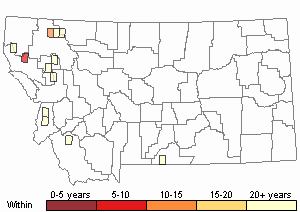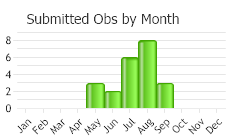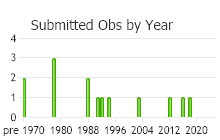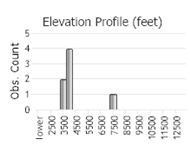View in other NatureServe Network Field Guides
NatureServe
Montana
Utah
Wyoming
Idaho
Wisconsin
British Columbia
South Carolina
Yukon
California
New York
Heartleaf Marsh Moss - Calliergon cordifolium
General Description
Plants: Pleurocarpous. Growing in open clumps of ascending shoots or interwoven into mats (Lawton 1971), light green to green (FNA 2014), becoming brown proximally with age. Stems 4-16 cm tall or more, few-branched or simple (Lawton 1971), the branching radial; terminal cell of axillary hair long and quadrangular to short and very narrow; possessing a central strand and without a hyalodermis; exterior pseudoparaphyllia wide (FNA 2014), occurring at leaf bases (Crum & Anderson et al. 1981).
Stem Leaves: Densely spaced and overlapping near the shoot ends, lax proximally, spreading about 45 degrees or more (Lawton 1971), developing a narrow, pointed bud at the stem apex (Flowers 1973), 2-4 mm in length, 1-2 mm in width (Lawton 1971), heart- to egg-shaped and somewhat deltoid, not pleated longitudinally (FNA 2014), slightly cupped, a little curved and twisted when dry (Lawton 1971); base widely extending down the stem (FNA 2014) but not distinctly auricled (Smith 1980); margins smooth (Crum & Anderson et al. 1981), flat or rolled up and inward (Lawton 1971); costa percurrent (FNA 2014) or subpercurrent, strong (Lawton 1971).
Leaf Cells: Laminal cells fine-walled (Lawton 1971); upper cells not much narrower than the lower cells; alar cells long and quadrangular, swollen and fine-walled, transparent (FNA 2014), larger than the cells above (Lawton 1971), the alar area deltoid and not precisely demarcated (FNA 2014); basal cells transparent, sometimes porose (Lawton 1971).
Diagnostic Characteristics
C. giganteum plants that do not develop the distinctive “spruce-like” form with successively smaller branches above may have their branches with the slender, ovate leaves confused with the stems and branches of C. cordifolium. However, the alar region’s boundary in C. giganteum is well-defined rather than gradually transitioned, the plants are occasionally light pink (never the case with C. cordifolium), and they grow in habitats lower in nutrients and slightly higher in mineral content (FNA 2014).
Calliergon stramineum resembles C. cordifolium but has an alar region that is egg-shaped and the boundaries sharply defined rather than a somewhat wide deltoid alar region with imprecise boundaries (FNA 2014).
Range Comments
North American Range
AK to NL and NS (except YT), WA, MT, CO, MN to IL and WI, TN, NC, MA n and ne to ME (FNA 2014). Known in Montana from Beaverhead, Carbon, Flathead, Glacier, Lake, Lincoln, Ravalli, and Stillwater Counties (Elliott 2016).
Observations in Montana Natural Heritage Program Database
Number of Observations: 24
(Click on the following maps and charts to see full sized version)
Map Help and Descriptions
Relative Density

Recency



 (Observations spanning multiple months or years are excluded from time charts)
(Observations spanning multiple months or years are excluded from time charts)
Habitat
Damp to wet, somewhat high-nutrient fens, forested swamp margins (FNA 2014), bog forests (Crum & Anderson et al. 1981), edges of wet places, waterways (FNA 2014), shallow waters (Elliott 2016), sometimes emergent or briefly underwater (Crum & Anderson et al. 1981).
Reproductive Characteristics
Autoicous (FNA 2014) or occasionally several archegonia mixed with perigonial buds (Crum & Anderson et al. 1981). Seta 3-6 cm in height, russet. Capsule theca to 2.5 mm in length (Lawton 1971), inclined to drooping, bowed, the neck narrowed (Crum & Anderson et al. 1981); exostome with an external network of lines below and toothed above (FNA 2014), ochre; cilia knobby, grouped in 2’s and 3’s (Crum & Anderson et al. 1981).
Stewardship Responsibility
References
- Literature Cited AboveLegend:
 View Online Publication
View Online Publication Crum, H.A. and L.E. Anderson. 1981. Mosses of Eastern North America. 2 volumes. Columbia University Press, New York. 1328 pp.
Crum, H.A. and L.E. Anderson. 1981. Mosses of Eastern North America. 2 volumes. Columbia University Press, New York. 1328 pp. Elliott, J.C. and A.K. Pipp. 2018. A Checklist of Montana Mosses (1880-2018). Updated 3 January, 2020. Montana Natural Heritage Program, Helena, Montana. 73 pp.
Elliott, J.C. and A.K. Pipp. 2018. A Checklist of Montana Mosses (1880-2018). Updated 3 January, 2020. Montana Natural Heritage Program, Helena, Montana. 73 pp. Flora of North America Editorial Committee, eds. 2014. Flora of North America North of Mexico. Volume 28. Bryophytes: Mosses, Part 2. Oxford University Press, Inc., NY. xxi + 702 pp.
Flora of North America Editorial Committee, eds. 2014. Flora of North America North of Mexico. Volume 28. Bryophytes: Mosses, Part 2. Oxford University Press, Inc., NY. xxi + 702 pp. Flowers, S. 1973. Mosses: Utah and the West. Brigham Young University, Provo, Utah. 567 p.
Flowers, S. 1973. Mosses: Utah and the West. Brigham Young University, Provo, Utah. 567 p. Lawton, E. 1971. Moss Flora of the Pacific Northwest. Hattori Botanical Laboratory. Japan: Yamabuki-cho, Shinjuku-ku, Tokyo. 362 pages plus appendices.
Lawton, E. 1971. Moss Flora of the Pacific Northwest. Hattori Botanical Laboratory. Japan: Yamabuki-cho, Shinjuku-ku, Tokyo. 362 pages plus appendices. Smith, A.J.E. 1980. The Moss Flora of Britain and Ireland. Cambridge University Press, Cambridge. 705 pp.
Smith, A.J.E. 1980. The Moss Flora of Britain and Ireland. Cambridge University Press, Cambridge. 705 pp.
- Additional ReferencesLegend:
 View Online Publication
View Online Publication
Do you know of a citation we're missing? Elliot, J. C. 1993. Second checklist of Montana mosses. Unpublished report. U.S. Forest Service, Region 1. Missoula, MT. 45 pp.
Elliot, J. C. 1993. Second checklist of Montana mosses. Unpublished report. U.S. Forest Service, Region 1. Missoula, MT. 45 pp. Lawton, E. 1971. Keys for the Identification of the Mosses on the Pacific Northwest. Reprinted from 'Moss Flora of the Pacific Northwest'. Published as Supplement No. 2 of the Journal of the Hattori Botanical Laboratory. Nichinan, Miyazaki, Japan. 66 pp.
Lawton, E. 1971. Keys for the Identification of the Mosses on the Pacific Northwest. Reprinted from 'Moss Flora of the Pacific Northwest'. Published as Supplement No. 2 of the Journal of the Hattori Botanical Laboratory. Nichinan, Miyazaki, Japan. 66 pp.
- Web Search Engines for Articles on "Heartleaf Marsh Moss"





